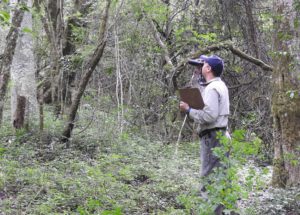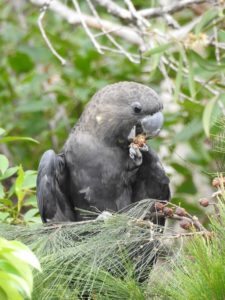After bushfires ravaged parts of Australia in 2019-2020, a variety of native wildlife species faced a multitude of risks to their populations with the destruction of natural habitats and food sources.

Associate Professor Guy Castley on the lookout.
Among those were the South-Eastern Glossy Black-Cockatoos, which are found along the East of Australia from South-East Queensland to Eastern Victoria.
On Saturday, March 26, volunteer citizen scientists will join ecologists for the Great Glossy Count, a national survey being coordinated by BirdLife Australia and the Glossy Black Conservancy to collect data that supports vital bushfire recovery and conservation work for the South-Eastern Glossy Black-Cockatoo.
Associate Professor Guy Castley from Griffith University’s School of Environment and Science and Centre for Planetary Health and Food Security is a partner of the Glossy Black Conservancy. He said the event would collect important data about where the cockatoo are and how they may have responded to the recent bushfires.
“Glossy Black-Cockatoos were severely impacted by prolonged droughts and subsequent severe bushfires which raged across Australia in 2019-20, destroying feed trees and essential habitat,” Associate Professor Castley said.
“The species faces a number of threats, but the primary driver is habitat loss across much of its range. More recently, the remaining habitat has been severely affected by the bushfires, but also extended drought. These compound effects reduce the availability of foraging and nesting habitat.

Glossy Black Cockatoos only feed on sheoak trees. Credit: Guy Castley
“In coastal areas, ongoing urban development can also threaten the species as more habitat is cleared and what remains becomes more fragmented.”
The South-Eastern Glossy Black Cockatoo’s national conservation status is currently under review, however it could soon be listed as ‘Vulnerable’ at a national level (it has been previously listed separately by each state).
Associate Professor Castley said citizen scientists were therefore crucial to learning more about the species and threats to their habitat.
“This species is in decline due to the threats above but the rates may vary from one region to the next,” he said.
“The overall population is estimated at less than 10,000 mature birds in the latest Action Plan for Australian Birds but is declining in many areas.
“We need to collect data to improve our understanding of how a specialised species such as the South-Eastern Glossy Black Cockatoo is able to recovery from such events and which areas might serve as important refugia.”
The Great Glossy Count is presented by BirdLife Australia and the Glossy Black Conservancy. It is funded by Birdlife Australia supporters and a grant awarded under the Australian Government’s Regional Bushfire Recovery for Multiregional Species and Strategic Projects Program.

